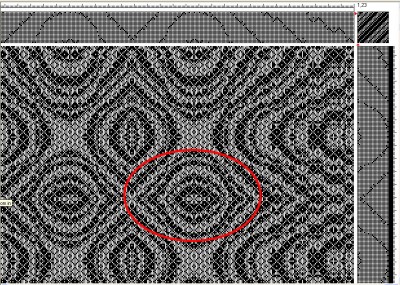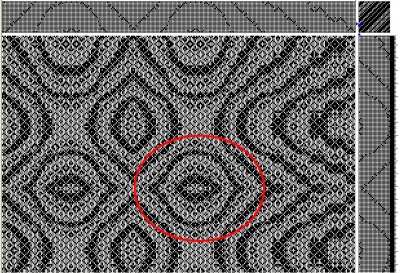I took Bonnie’s advice and looked at tie-ups with only 1-3 and 3-1 twills, then changed one of the 1/3’s to a 2/2 and looked at the tie-up. Wow! It made a HUGE difference to the sharpness of the lines.
Behold:

And here is what happens after converting just one of these to a 2-2 twill:

I’ve circled the same motif in red to show how the “echoed” lines are softened and blurred as soon as the 2-2 tie-up is introduced. The result is a radically different look, even though the lines are the same.
Wow! That’s really interesting, and not something I’d thought of before. Thank you, Bonnie!
I think that, for the purposes of this first shawl, I’m going to stick with 1/3 and 3/1 tie-ups for now. I think bolder echoes will “play” better in the black weft than softer ones.
Weaving-wise, I think the order I’m going to do the pieces in is: black cashmere weft (because it’s the easiest to re-do if I botch the weaving), then the red-orange-gold weft in a complex pattern, then the pale blue/pale green with complex pattern, and finally the simple goose-eye pattern with a machine knitted/dyed red-orange-gold weft. I want to do the black first because it’s simplest (and it feels SO nice), and the goose-eye pattern last because if that one winds up a little short, it won’t bother me as much – I can still write the article for WeaveZine, and I’d rather have that one be imperfectly short than the other ones. I can always make a bag out of it or something if it isn’t long enough for a shawl.
I am discovering an unfortunate fact about my AVL WDL, though: it simply is not set up to handle even mildly tight tension without a brake release (which it doesn’t have). Advancing the warp against the live weights strains the rather flimsy X-frame, so the beams wobble close to popping out of their axle holes – I have to bang up against the side of the frame to re-set the beams in their proper places. And the gear teeth have a tendency to slip, bringing the weights crashing down. Next time I move to the Peninsula, rent a bigger apartment and then consider a bigger, more solid loom. AVL is upgrading the gear teeth from (relatively flimsy/slippery) plastic to aluminum, but that won’t solve the problem of the X-frame flexing. I’ll live with it for now, having no better option.
Don’t expect much out of me for the next few days – tomorrow night is a Black Sheep guild meeting, and after that it’s off to Davis for the Davis Bike Club’s Foxy Fall Century! Mike will be riding in his first century (100-mile ride) ever, I’m going to be lazy and only do a metric (65 miles). Mike rides so much faster than me, though, that we think we should finish around the same time. But just in case, I’m going to bring my laptop. If I finish up early, I can play with tie-ups in Fiberworks PCW, or maybe make up a Weavolution or AIDS Lifecycle logo in Photoshop, to silkscreen in colored cocoa butter for chocolates.

For clear design with least number of echos, use
3/1/3/1 / 1/3/1/3/1/3/1/3 or similar; group some 3/1 together, then 1/3. To soften, use 2/2 as a transition: 3/1/3/1/2/2/ then 1/3/1/3 /2/2.
Try a bunch of tie-up options on the screen. Remember I said you use the tie-up to “color in” the design? Now you get it.
Bonnie